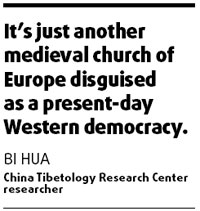Tibet 'government' a theocratic power
(China Daily)
Updated: 2008-04-30 07:27
Updated: 2008-04-30 07:27
The Tibetan "government-in-exile" is a theocratic power, integrating a church and a "state" with the Dalai Lama at the top, a senior Tibetologist said.
While claiming to maintain a division of power, the Tibetan "government-in-exile" has a legislative framework (the Assembly of Tibetan People's Deputies), executive body (kashag) and judiciary (the Tibetan Supreme Justice Commission), but the Dalai Lama is still at the top with a firm grip on religious and executive power, Bi Hua, a senior researcher with China Tibetology Research Center, said.
The nature of its "integration of church and state" remains unchanged, she said.
"It's just another medieval church of Europe disguised as a present-day Western democracy."
The Dalai Lama is the holy representative of Tibetan religious worship, but both the "government-in-exile" and its constitution consider him the top leader, which shows that under the guise of a division of powers and democratic politics, the "government" in fact features strong religious and feudal factors, she said.

"Its ridiculousness is self-evident. An incarnated Lama who represents holy rule is considered a representative of civil rights and a fighter for democracy," Bi said.
In the "government-in-exile", both the speaker of the assembly and the kalons (ministers) in the kashag are subject to the Dalai Lama. The Dalai Lama is both "holy" and the "ruler" as he has the final say over the resolutions of the kashag and the assembly and the appointment of "government" officials, she said.
The Dalai Lama even has the power to decide whether and when to convene or dissolve assembly meetings, she said.
The Dalai Lama's supreme power over religion and politics is enshrined in the constitution of the "government-in-exile", which is an important characteristic of its long-held tradition that integrates both politics and religion, she said.
The Dalai Lama is a religious figure, but performs his role as a "head of state". His brothers DamCe Tubdainnorb and Dainzin Qoi'gyai are living Buddhas, but also serve officials in the "government", she said.
A number of monks also hold posts in the "government-in-exile", she said, adding that the current kalon tripa (chief minister of the cabinet), Samdhong Rinpoche, is a living buddha.
The "government-in-exile" wants to separate Tibet from China and restore its rule with political and religious power under the Dalai Lama's control, she said.
Both the 1963 constitution and 1991 amendments admit the supreme status of the Dalai Lama in the "government", Zhu Xiaoming, a research fellow with China Tibetology Research Center, said.
The 1991 edition of the constitution merely added such words as "freedom", "democracy" and "peace", but the two constitutions are fundamentally the same in seeking Tibetan independence, he said.
The Dalai Lama's backers' claim that they reign over "Greater Tibet", which covers an area of 2.4 million sq km in Tibet, Qinghai, Sichuan, Xinjiang, Yunnan and Gansu, is groundless, he said.
The Dalai Lama also practices cronyism when appointing officials, experts have said.
The Dalai Lama's second eldest brother, Gyalo Toinzhub, has held important posts in military, diplomatic and financial departments. Losang Samdain, the third eldest brother, is now in charge of the health section, while his younger sister, Jezuin Bai'ma, is the chief of the education department. His brother-in-law was "minister of security" for 18 years after 1968. And many of his relatives have held important posts in his "government", they said.
As a result of theocratic rule, internal factionalism, religious persecution and assassinations have been rife in the history of his exiled "government". Many monks have been expelled from monasteries for believing in different gods, they said.
Xinhua
(China Daily 04/30/2008 page5)
|
||
|
||
|
|
|
|